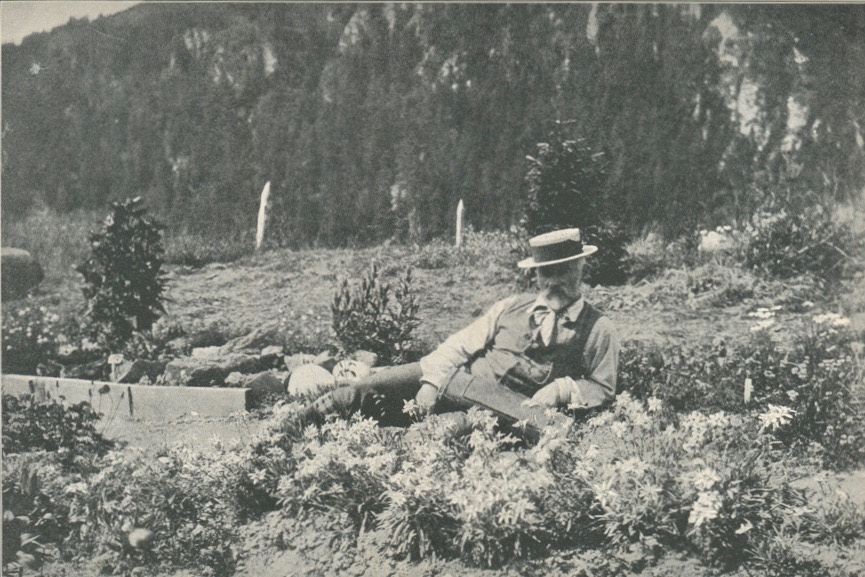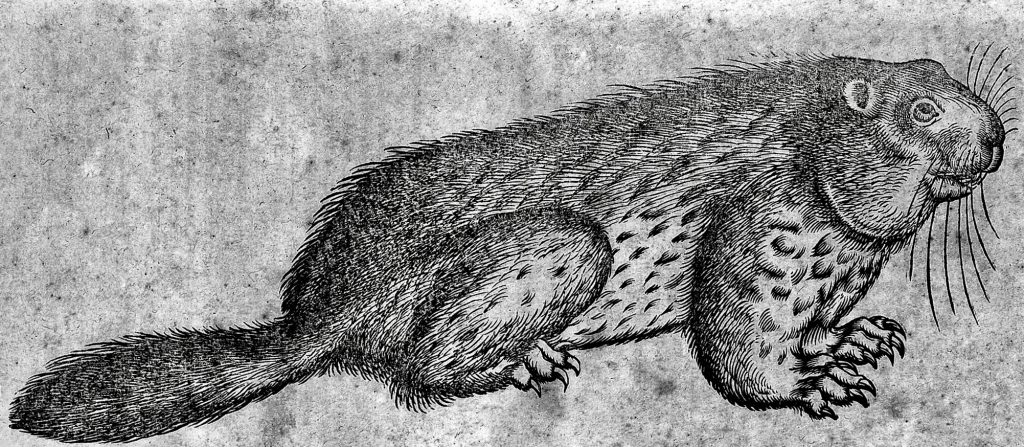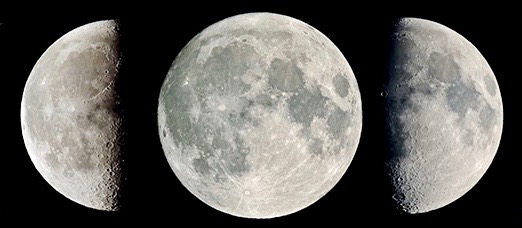The Marmot with the CollarDiary of a Philosopher
Appendix IX
Henry Correvon and The Flora of the Philosophical Marmot
Henry Correvon (1854 – 1939) was a contemporary and countryman of Eugène Rambert (1830 – 1886). It seems appropriate to illustrate “The Flora of the Philosophical Marmot” with details from Philippe Robert’s handsome watercolours, which appeared first in M. Correvon’s La flore alpine (1908).
Some of the identifications are perforce speculative. However, it is hoped that this appendix will confer, if not scent, at least colour, upon the world that the Philosophical Marmot inhabits.
Special thanks are due to Barnaby Probert (Plymouth) and his wife Sinta Wijayanti (Bandung, Indonesia), who fortuitously acquired a copy of Mr. E. W. Clayforth’s translation (1911) of La flore alpine (as Alpine Flora) in Blackwell while spending August in my Oxford residence. The conversation about Swiss flora that flowed between Oxford and Mtunthama has proved a pleasurable diversion at a time when England and Switzerland seem remote.
RLH8th September 2020
I. Flowers and Mosses
Flowers and Mosses are presented as they appear in the Tablets and are referenced by M (Marmot) Number.
Where either the same flower or a flower of the same genus is illustrated in M. Correvon's Alpine Flora, every illustration of that genus is reproduced.
Hugh Knott publishes his photographic album of “The Alpine Flora of Zermatt” here. It may be searched by genus and species. His “Links and References” will interest those who wish to pursue contemporary Swiss botany.
Gentiane
Enzian / Alpine Gentian
M.004 … ils sont presque aussi minces que des feuillets de gentiane...
M.046 … toutes les tiges de gentiane se dressent encore fièrement…
M.090 … les gentianes aux coupes bleues brillent à l’envi…
M.134 … il boit le sang de ses victimes, comme nous buvons la rosée dans les coupes de la gentiane...
Gentiana nivalis
Fruits veloutés
Samtweiche Früchte / Velvet Fruits
M.023 … nous ne vivons que… de fruits veloutés…
Vaccinium myrtillus (vel uliginosum)
The velvet fruits known to the Philosophical Marmot are most likely V. myrtillus, the Bilberry (Myrtille, Heidelbeere), or V. uliginosum, the Wortleberry (Airelle bleue, Moorbeere).
Trèfle [d’or]
Goldklee / Golden Clover, Large Hop Trefoil
M.020 … la lune du trèfle, qui est celle où fleurit le trèfle d’or…
M.023 … le trèfle d’or, aux têtes succulents… voilà le menu d’un déjeuner de marmotte…
M.037 … mais j’étais plus maigre qu’eux tous, n’ayant pas encore goûté du trèfle de la montagne…
M.061 … la vallécule où fleurit le trèfle d’or…
M.101 … je parie que plusieurs n’ont pas mangé dix fleurs de trèfle pendant ce temps-là…
M.134 … il lui faut des marmottes ou des lièvres, comme à nous le trèfle...
M.148 “La différence est grande aussi entre les herbes de ce pays et les fleurs du trèfle d’or.”
Trifolium Badium (vel spadiceum)
Rosage
Rhododendron / Rhododendron, Alpine Rose
M.022 … comme je cheminais là-bas, entre quelques buissons de rosage…
Rhododendron ferrugineum (vel hirsutum)
One of the principal delights of the translator’s life has been to ascend Nepalese mountain passes amidst the “Himalayan spring”, when the slopes are bright with Rhododendron. This is a sight to have inspired the Philosophical Marmot with vitality anew and the appeal of fresh adventure.
Mutelline
Mutterwurz / Alpine Lovage, Mountain Lovage
M.023 … la mutelline, dont l’ombelle craque et se fonde sous la dent… voilà le menu d’un déjeuner de marmotte…
Artemisia mutellina
Potentille
Fingerkraut / Alpine Cinquefoil
M.023 … la potentilla… voilà le menu d’un déjeuner de marmotte…
Potentilla aurea
Saxifrage
Steinbrech / Alpine Saxifrage
M.023 … les saxifrages… voilà le menu d’un déjeuner de marmotte…
M.045 … une belle touffe de saxifrage d’automne…
Saxifraga oppositifolia
Vanille
Brunelle / Black Vanilla Orchid
M.023 … la vanille aux parfums voluptueux… voilà le menu d’un déjeuner de marmotte…
Nigritella angustifolia
Aster
Aster / Alpine Aster, Blue Alpine Daisy
M.023 … l’aster au rayon bleu… voilà le menu d’un déjeuner de marmotte…
Aster alpinus
Vergerette
Flöhkraut / Fleabane
M.023 … les fines vergerettes… voilà le menu d’un déjeuner de marmotte…
Erigeron alpinus
Achillée
Schafgarbe / Yarrow
M.023 … l’achillée à l’odeur amère et fortifiante… voilà le menu d’un déjeuner de marmotte…
Achillea moschata
[A. moschata is not illustrated in M. Correvon’s book.]
Armoise
Beifuß / Wormwood
M.023 … les armoises dont l’arome enivre… voilà le menu d’un déjeuner de marmotte…
Artemisia absinthium
If the “intoxicating aroma” of Wormwood implies drink that is on occasion stronger than dew, such as Absinthe or Genepi, some of the Philosophical Marmot’s less restrained diary entries (such as those that express his desire for the tumbling of frozen and sleeping marmots down mountainsides) may be explained.
Alchimille
Frauenmantel / Lady's-mantle
M.023 … les gouttes d’eau qu’on trouve le matin dans les feuilles d’alchimille…
M.134 … il boit le sang de ses victimes, comme nous buvons la rosée… dans les gobelets de l’alchimille…
Alchemilla alpina
Parnassie
Leberblume / Bog-star
M.045 … j’ai passé indifférent à côté des parnassies blanches...
Parnassia palustris
Saussurée
“Pflanze” / Alpine Saw-wort
M.045 … le parfum d’une petite plante tardive, une saussurée, je crois...
Saussurea alpina
[S. alpina is not illustrated in M. Correvon’s book.]
Mousses noires
Schwarzmoos / Black Mosses
M.046 “Une seule source continue à couler dans le voisinage de mon terrier, la source dite des mousses noires.”
M.148 … l’eau qui suinte le long de ce rocher… ne vaut pas celle de la source aux mousses noires…
Andreaea alpina (vel rothii)
[Andreaea is neither described nor illustrated in M. Correvon’s book.]
The Spring of Black Mosses commands a special place in the Philosophical Marmot's affections.
Soldanelle
Soldanelle / Alpine Snowbell, Blue Moonwort
M.069 “J’ai cédé aujourd’hui à un désir de gourmet. J’ai été faire un déjeuner de soldanelles, le premier de l’année. Certaines pentes en étaient roses. C’est la plus fine des fleurettes du printemps. Quand on la regarde au soleil, on voit dans la chair même de la fleur, entre les veines, une multitude de cristaux, infiniment petits, mais qui scintillent. La table des dieux a-t-elle rien de plus exquis que ces corolles cristallines qui se fondent en ambroisie? Brouter la soldanelle, à l’aube, quand sa petite cloche inclinée vers la terre est encore humide de rosée: voilà un plaisir que le ciel, juste au moins une fois, a reservé à la seule race des marmottes.”
M.134 … il lui faut des marmottes ou des lièvres, comme à nous… la soldanelle…
M.198 … nous avions brouté… la soldanelle…
Soldanella alpina
Anémone
Anemone / Alpine Anemone, Windflower
M.090 … les anémones jaune pâle… brillent à l’envi...
M.198 … nous avions brouté l’anémone…
Anemone sulfurea
Auricule
Aurikel / Mountain Cowslip, Bear's Ear
M.090 … les auricules roses… brillent à l’envi…
Primula auricula
M. Correvon is of the view that P. auricula has a “golden flower”. It is at least possible that P. hirsuta (P. viscosa) – “rosy flowered… bright carmine…” – is intended instead.
Myosotis
Vergißmeinnicht / Alpine Forget-me-not
M.097 “Nous avons dans cette région-ci des fleurs bleues, très joliment découpées, que feu ma femme appelait, je crois, des myosotis. – Ma femme savait les noms de toutes les fleurs de la montagne.”
Myosotis alpestris
Forget-me-nots are not witnessed. However, they are recalled as a point of comparison for King of the Alps, whose name is unknown to the Philosophical Marmot (vide infra). The conjunction of Forget-me-nots and his wife’s memory is poignant.
[Roi-des-alpes]
[Himmelsherold] / [King of the Alps, Arctic Alpine Forget-me-not]
M.097 “Il n’y avait plus de gazon au sommet de la Becca de l’Oura; mais il y poussait entre les pierres quelques pauvres graminées et des mousses fleuries d’une merveilleuse beauté, dont une, entre autres, m’était complétement inconnue et m’a transporté d’admiration… Celles que j’ai admirées là-haut leur ressemblent beaucoup; mais elles sont plus grandes, d’un bleu plus riche, et la plante qui les porte est une espèce de mousse, dont les creux des rochers sont tapissés. Chaque brin de mousse a sa fleur, et comme tous les brins de mousse se touchent, la place manque pour les fleurs. On ne voit plus la verdure, on ne voit que des gazons bleus. Il s’en exhale un parfum discret, subtil, à la fois doux et sauvage, léger comme l’air qu’elles respirent, l’air du ciel. Je ne sais rien de leur goût. C’eût été péché d’en brouter une seule, elles étaient si belles! Mais on dirait qu’elles ont des yeux. On se penche vers elles, tout bas, pour les regarder de plus près, et ce sont elles qui vous regardent.”
Eritrichium nanum
The Philosophical Marmot is a connoisseur of flowers but no botanist. Mosses do not bear flowers. However, it is satisfying that King of the Alps is known to M. Correvon also as “the Blue Moss” - and this, together with the likeness to Forget-me-nots (vide supra), except “larger, of a richer shade of blue”, suggests that it is this flower that so enchanted the Philosophical Marmot atop the Becca de l’Oura. The translator owes this identification to Mr. Probert. We look forward to the day when it will be possible once again to “leap from peak to peak” in search of E. nanum.
Graminées
Halme / Grasses
M.176 … quelques graminées inclinent sur ce miroir leurs tiges chargées d’épillets bigarrés…
Poa alpina
[P. alpina is neither described nor illustrated in M. Correvon’s book.]
The Philosophical Marmot is disdainful of most grasses as so lacking in aroma that they are fit only for the diet and forms of White Hares. However, the grasses that he discovered in the cave are clearly special and deserving of record in “The Flora of the Philosophical Marmot”. Provisional identification is made with P. alpina, Alpine Meadow Grass or Alpine Bluegrass.
Violette
Veilchen / Alpine Yellow-Violet
M.176 … et dans une fente du rocher, à l’entrée, une touffe de petites violettes dorées baigne ses feuilles dans le ruisselet murmurant...
M.195 … elle n’a rien eu de plus pressé, en arrivant, que de brouter les violettes...
Viola biflora
The “golden violets” that the Philosophical Marmot saw in the cave are most likely V. biflora. The “violet crystals” of the cave are true violet: perhaps amethyst, and a striking juxtaposition.
Muguet
“Don Juan” / “Snapdragon”
M.184 … il me prend des fureurs sombres à la pensée de ce muguet que je viens de revoir...
Convallaria majalis
Muguet is properly Lily of the Valley (Maiglöckchen). However, it is used here figuratively of a young marmot who is the Philosophical Marmot’s rival in a widow’s affections. “Snapdragon” (arch.), although a different flower, best captures the sense and continues the image in English. Described and illustrated is L. Martagon, the Turk's-cap Lily.
II. Trees
Trees are presented as they appear in the Tablets and are referenced by M (Marmot) Number.
It is hoped to illustrate the trees known to the Philosophical Marmot in due course.
Hugh Knott publishes his photographic album of “The Alpine Flora of Zermatt” here. It may be searched by genus and species. His “Links and References” will interest those who wish to pursue contemporary Swiss botany.
Aune
Erle / Alder
M.011 … une galerie de sûreté, débouchant sous un buisson d’aunes...
Alnus alnobetula
Arolle
Arve / Pine
M.023 … nous ne vivons que… d’amandes d’arolle…
M.034 … un jour, il m’apporta une pomme d’arolle, qui avait encore quelques amandes...
M.134 … il était arrivé jusqu’à un étranglement formé par une racine d’arolle…
M.135 … le jour où l’homme à longue et fine crinière, qui me donnait des amandes d’arolle…
Pinus cembra
Hêtre
Buche / Beech
M.139 … les hètres, par exemple, dans le bas de la vallée… sont gelés extérieurement…
Fagus sylvatica
Mélèze
Lärche / Larch
M.139 … ou les mélèzes, sont gelés extérieurement…
Larix decidua
If
Taxus / Yew
M.147 … l’entrée en est immédiatement sous le rocher, cachée par un buisson d’if…
Taxus baccata
Houx
Stechpalme / Holly
M.152 … je sèmerai de feuilles de houx le foin de mon dortoir...
M.153 … il m’a fallu deux jours de recherches pour trouver une plante de houx...
M.154 … j’ai passé ma journée à disposer mon houx...
M.155 … quel plaisir j’aurais à lui décrire ce terrier, et mon foin semé de houx…
M.166 … si je n’avais pas eu cette galerie à creuser, j’aurais eu plus que le temps d’entrer… et d’en emporter au moins une dans ma grand’salle aux feuilles de houx…
M.181 … cela vaudrait mieux que le houx…
M.194 … la belle philosophie que celle qui a besoin de feuilles de houx pour se tenir éveillée!...
Ilex aquifolium
III. Henry Correvon's Obituary and Alpine Flora
We present here, in honour of Henry Correvon, his obituary and four extracts from the book which provides the illustrations for “The Flora of the Philosophical Marmot”: i) Introductory Matter, ii) the General Introduction, iii) Endogens and Acrogens, and iv) the Index.
M. Correvon is photographed amidst Edelweiss at the Garden Linnaea.
The reason for the absence of Leontopodium nivale from “the luncheon of a marmot” is a question that students of the Philosophical Marmot will surely wish to address.

Obituary
Though better known as a horticulturalist than as a botanist, Henry Correvon made considerable contributions by his numerous publications in botanical science. His death in his eighty-fifth year on May 11 leaves a notable gap among the devotees of alpine plants, whom he has done so much to encourage and assist by his own enthusiastic labours.
Born at Iverdon in 1854, Correvon was educated in this little Swiss town, and, losing his father at an early age, he was sent to learn horticultural practice first to Geneva, then to Zurich, Frankfort, Erfurt and finally to the Jardin des Plantes in Paris, where he received botanical as well as horticultural training. Thus well equipped, he returned to Iverdon to take charge of the horticultural establishment founded by his grandfather, which had suffered greatly from the neglect of the tenant who had carried on the undertaking. Capable and energetic, Correvon commenced to work up this family heritage, but, alas, only to see most of his improvements totally destroyed by a devastating cyclone in July 1877. The low-growing alpine plants alone survived the ravages of the storm. He transferred his energies to Geneva, where he established a nursery for alpine plants, in the cultivation of which he was so successful that he ultimately purchased in 1902 a large vineyard at Chêne-Bourg high above Geneva. Here he created the wonderful garden “La Floraire” known to all cultivators of alpine gardens. To it he had transported limestone rocks from the Salève and the Jura and granite blocks from the Alps so as to have suitable surroundings for his pet plants.
Correvon’s interest in these was not limited to those in his own garden. He was one of the originators of “La Linnea”, the alpine garden at Bourg St. Pierre, now under the management of the University of Geneva. He was also concerned in the management of the alpine garden on the Rochers de Naye above Montreux and for a time with that above Saint-Corgue. His love for these, and other efforts for the preservation of the mountain plants, made him a prime mover in the formation of the Swiss Nature Protection Society.
Alphonse de Candollo persuaded Correvon to learn English, and for some years he acted as a correspondent of the Garden. In 1886 he visited England and wrote enthusiastically about some of the gardens he saw, and spoke with admiration of the cultivation of the terrestrial orchids by various British horticulturists. This group of plants was particularly dear to him and led to his publication of a little book in 1893 on “Les Orchidées rustiques”, followed in 1899 by his “Album des Orchidées”, of which a second edition has appeared. His publications were, however, not limited to orchids. They included books on trees, ferns, flowers of fields and forests, water and marsh plants. His book on “Rock Garden and Alpine Plants”, translated from the French edition, was published in New York. His “Alpine Flora”, with its wonderfully artistic representations of the plants described, appeared in an English translation in London.
Correvon was an indefatigable worker and an excellent lecturer. Ten years ago, at the age of seventy-three years, he undertook a visit to the United States, where he gave some forty lectures and addresses in English to promote the interest in alpine gardens. He was an honorary member and correspondent of many horticultural societies and was awarded an honorary doctorate of the University of Geneva in 1931.
He retained his full powers of body and mind until the end, and his beloved garden at Chêne-Bourg is assured of its continuity in the hands of his son and his grandson, both trained gardeners and possessing Henry Correvon’s devotion to alpine plants.

